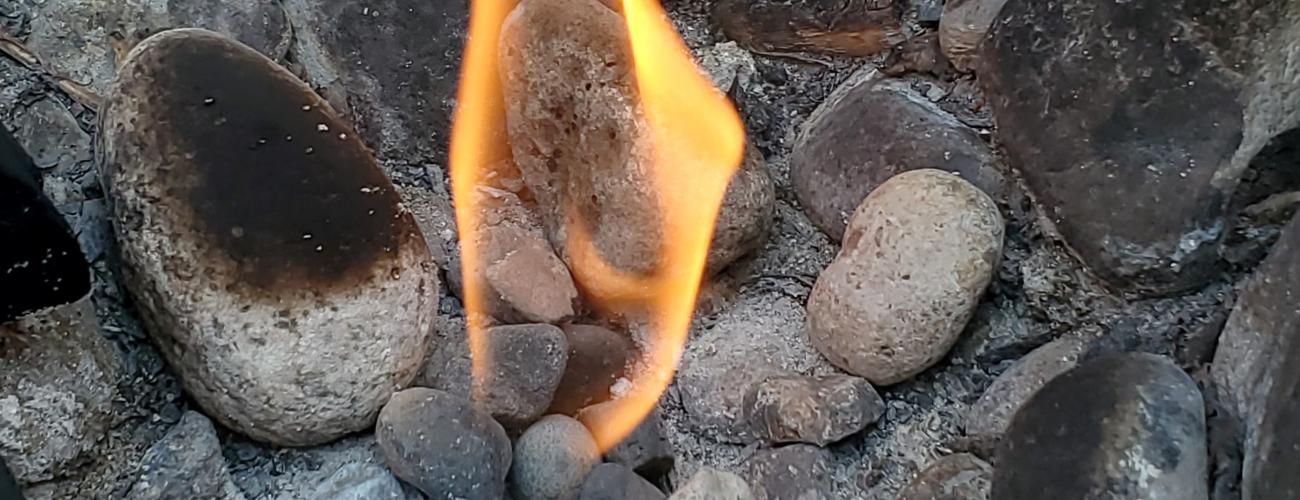Flaming Geyser State Park History
Flaming Geyser State Park straddles the Green River at the lower end of the Green River Gorge, a unique place where sandstone bedrock, covered by glacial deposits in most of the Puget Sound lowlands, is revealed by the downcutting of the river through the formation. Seams of coal interwoven with the sandstone fueled a mining industry in the local area. On October 4, 1911, coal miner Eugene Lawson drilled a test bore in today’s park area, attempting to locate a coal seam. At 390 feet deep, he found a seam 6.5 feet thick. Methane gas began releasing out of the hole as the drill depth passed 900 feet, on its way to a final depth of 1,403 feet. Returning to the drilled hole a week later, Lawson observed gas and saltwater “bubbling furiously” out of the hole. He ignited the gas and it burned, with a flame from 5 inches to three feet in height, occasionally leaping up to fifteen feet. The methane seep has depleted over time, and the flame sometimes blows out. It is usually easily relit, though, and serves as a reminder of the park’s past.
Indigenous Lands
Flaming Geyser State Park lies within the traditional territories of Coast Salish people whose present-day descendants include members of the Muckleshoot Indian Tribe, Snoqualmie Indian Tribe, and the Confederated Tribes and Bands of the Yakama Nation. For thousands of years the Green River watershed has provided habitat for a diverse community of life that forms the basis of their cultures, especially around the harvest, preservation and stewardship of salmon in the Green River. Traditionally, resource gathering was performed with temporary summer residences at specific resource sites and larger permanent winter villages in locations protected from cold-season weather.
Treaties and Conflict
The Oregon Treaty between the United State and Great Britain in 1846 established the border between the two countries at the 49th parallel, putting the lands making up today’s Flaming Geyser State Park under American jurisdiction. Passage of the Donation Land Claim Act of 1850 by the US Congress allowed American settlers to claim land in the territory.
Local tribes ceded ownership of the area to the US federal government under duress in the Treaty of Medicine Creek in 1854. Poor communication at the treaty council and provocations by territorial officials and local settlers afterwards led to armed conflict between allied tribes against US government forces and volunteer militias. Indian Agent Michael Simmons ordered all noncombatant tribal members to an internment camp on Fox Island in November 1855. The Medicine Creek Treaty was then renegotiated at the Fox Island Council on August 5, 1856. The parties reached an agreement to relocate and enlarge the Nisqually and Puyallup Reservations and added the Muckleshoot Reservation, located about five miles west of today’s Flaming Geyser State Park. The treaty revisions were approved by President Franklin Pierce on January 20, 1857. As pressure from incoming settlers increased, Indigenous people moved from traditional village sites throughout the Green River watershed to the established Muckleshoot Reservation.
After government land surveys were completed in 1883, the land in today’s Flaming Geyser State Park passed into private ownership in 1895 as part of a grant of nearly 40 million acres authorized by the US Congress to the Northern Pacific Railroad to assist the company in building railroad lines into the western states. The railroad sold most of the lands to raise money for its ventures.
Becoming a State Park
E.W. Wiese opened a private park at the Flaming Geyser in 1925, consisting of approximately 300 acres along the Green River and surrounding hillsides. Land was cleared to establish picnic grounds and modern conveniences for visitors, including a pool with diving board, camp stoves, picnic tables, and restrooms. By the mid-1960s, the property was owned by the Washington Recreation Company. After public health violations were charged against the company, Superior Court Judge F.A. Walterskirchen issued a temporary restraining order closing Flaming Geyser Park in August 1965. One of the park’s operators, William Lenhart, was convicted of violating five health department rules in January 1966.
Conservationist Wolf Bauer was a mountain climber, kayaker and retired engineer who had previously launched America’s first mountain search and rescue organization in Seattle. In 1966 he authored and photographed a widely read article in the Seattle Times Sunday Magazine that showed the Green River Gorge as a natural marvel. Bauer passionately made the case for protecting what he called “A Ribbon of Wilderness in Our Midst.” On April 24, 1969, Governor Daniel J. Evans approved Engrossed Senate Bill 514, stating that “A twelve mile strip [of the Green River Gorge]…needs to be acquired and developed as a conservation area to preserve this unique area for the recreational needs of the region.” The Washington State Parks and Recreation Commission (WSPRC) began purchasing land, starting with the Flaming Geyser Park property in October 1969. In 1972, the state acquired an additional 187 acres of land directly across the river including the former Stark family dairy farm. Rounding out the park, 97 acres of fields and forests beside the Green River were leased from King County for park purposes. Flaming Geyser State Park opened to the public in July 1975 after over $300,000 in improvements, which included road work, a water system, parking areas, picnic areas, and a children’s playground. The dedication for the new state park occurred on August 15, 1975.
The WSPRC has continued to acquire lands in the Green River Gorge Conservation Area, totaling 2,285 acres as of 2023. The eastern part of the conservation area is anchored by Kanasket-Palmer State Park.
Sharing the histories of Washington’s state parks is an ongoing project. Learn more here.

